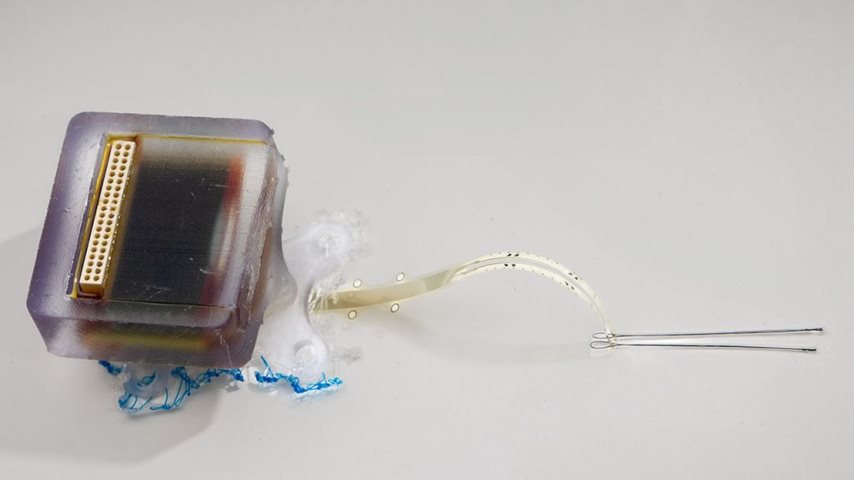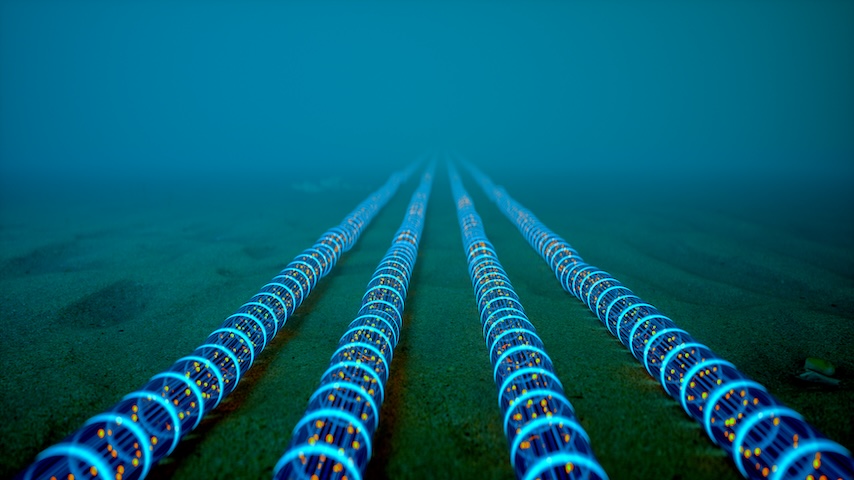Rebooting the Spinal Cord
Rebooting the Spinal Cord


Electric pulses are helping spinal cord injuries heal. The science behind the effect is only beginning to be understood.
Whether it’s shock therapy, deep brain stimulation, pacemakers, or tensor units, humans have been zapping themselves for potential health benefits for ages. But electricity may have healing powers as of yet untapped—specifically, for the spine.
Among the injuries that can befall a person or animal, damage to the spinal cord is among the worst. An inability to walk, limited overall mobility, and incontinence are a few of the many problems such an injury can induce. And, unlike other body parts, the spinal cord doesn’t grow back, leaving victims with little hope of recovery.
Theres’s long been evidence that applying a current to a spinal cord after an injury could help it rejuvenate. For one thing, when fetuses are developing, electric fields play a role in encouraging cells to grow and axons to branch. And scientists have known for decades that putting a charge into a petri dish of nerve cells causes axons to grow in parallel to the electric fields. Could a current applied to the site of a spinal injury similarly stimulate growth and repair?
To answer that question, a group of researchers at the University of Auckland in New Zealand created a tiny implant that could apply a low frequency electric field to such an injury. The device tested eight rats in the electric field to see if such stimulation would help them heal.
“This is something that could be translated to a human technology,” Bruce Harland said, a senior research fellow at the university, and the lead author of the paper “Daily electric field treatment improves functional outcomes after thoracic contusion spinal cord injury in rats,” which dropped this June in Nature Communications.
He continued, “But beyond that, there’s just answering this question—this basic science question—of whether these electric fields can cause healing and regeneration around the injury.”
Harland and his colleagues are certainly not the first to try to promote spinal healing with a pair of electrodes. However, previous attempts attached electrodes to muscles above the spinal cord. Stimulation had to pass through muscle, through the dura mater, and through spinal fluid. As a result, a lot of current had to be used, which degraded the electrodes.
Harland’s approach is more precise and much smaller.
You May Want To Read: Tiny, Dissolvable Pacemaker May Be Lifesaving for Babies
“It’s a really ultra-thin plastic which goes under the membrane, sits directly on the cord and allows us to use a lot less current,” he said. “The electrodes are a platinum base, but we coated them with this magical stuff called sputtered iridium oxide film.”
The iridium oxide turns the surface of the electrode moonlike, with many pits and hills that capture stray ions which would otherwise degrade the electrode.
With it, they were able to apply a current with an alternating polarity to the injury site for an hour a day over a period of weeks. During that hour, the polarity is pulsed between negative and positive every 250 milliseconds. Electric field treatment causes axons to grow toward the negative cathode. The speedy alternation allows this, while preventing “die back” in direction of the positive pole—a problem seen in previous research. The quick polarity changes reduce strain on the electrodes as well.
The treatment was clearly effective, as the rats that received it did better than the rats that didn’t. The rats which received treatment responded to touch sooner than the control group. There was no clear evidence that nerve cells had regenerated.
“We’ve done the analysis, and we haven’t found these effects,” said Harland. “But there are other explanations: Maybe this kind of stimulation is more neuro protective. So, rather than causing this massive regeneration, it causes less axons to die earlier in the injury. We have a lot of questions, and this is what we’re really looking into now.”
To get a bead on exactly what’s happening, they plan to use virus tracing, light sheet microscopy, and RNA analysis to see if and where axons may have grown. Also, to prevent any bits of the implant from staying in the body—an issue that cropped up in the research—they will be trying a new electrode that is essentially thousands of tiny electrodes tied together in a honeycomb pattern. They provide the same total surface area but are less likely to delaminate and leave behind any pieces.
Discover the Benefits of ASME Membership
They’ll also try electric fields with different parameters. For example, they may add a chip to power the implant so that the rats can receive 24 hours of stimulation a day instead of just one.
“We have no idea whether that’s the best dose,” said Harland. “We know that this treatment can be effective, and now I think it would be really exciting to try to hone in on the best recipe for repair.”
And if those trials are successful, they may soon move to sheep or pigs, and possibly to humans within the next five to ten years. Whether or not it will allow the wheelchair bound to walk again is an open question Harland’s research suggests that an implant like his is likely to provide some rehabilitation.
”There’s this real focus on getting people to walk again, to curing paralysis. And we came into this like everybody else,” he said. “But we have a lot of communication with the spinal cord community here, and what we’ve learned is that there are all sorts of quality-of-life issues that are a problem. It’s not just moving; it’s bladder function, sexual function, pain, temperature regulation, and pressure sores from being in a wheelchair. And sometimes a very small increase in function can go a long way.”
Michael Abrams is a science and technology writer in Westfield, N.J.
Among the injuries that can befall a person or animal, damage to the spinal cord is among the worst. An inability to walk, limited overall mobility, and incontinence are a few of the many problems such an injury can induce. And, unlike other body parts, the spinal cord doesn’t grow back, leaving victims with little hope of recovery.
Theres’s long been evidence that applying a current to a spinal cord after an injury could help it rejuvenate. For one thing, when fetuses are developing, electric fields play a role in encouraging cells to grow and axons to branch. And scientists have known for decades that putting a charge into a petri dish of nerve cells causes axons to grow in parallel to the electric fields. Could a current applied to the site of a spinal injury similarly stimulate growth and repair?
To answer that question, a group of researchers at the University of Auckland in New Zealand created a tiny implant that could apply a low frequency electric field to such an injury. The device tested eight rats in the electric field to see if such stimulation would help them heal.
“This is something that could be translated to a human technology,” Bruce Harland said, a senior research fellow at the university, and the lead author of the paper “Daily electric field treatment improves functional outcomes after thoracic contusion spinal cord injury in rats,” which dropped this June in Nature Communications.
He continued, “But beyond that, there’s just answering this question—this basic science question—of whether these electric fields can cause healing and regeneration around the injury.”
Harland and his colleagues are certainly not the first to try to promote spinal healing with a pair of electrodes. However, previous attempts attached electrodes to muscles above the spinal cord. Stimulation had to pass through muscle, through the dura mater, and through spinal fluid. As a result, a lot of current had to be used, which degraded the electrodes.
Harland’s approach is more precise and much smaller.
You May Want To Read: Tiny, Dissolvable Pacemaker May Be Lifesaving for Babies
“It’s a really ultra-thin plastic which goes under the membrane, sits directly on the cord and allows us to use a lot less current,” he said. “The electrodes are a platinum base, but we coated them with this magical stuff called sputtered iridium oxide film.”
The iridium oxide turns the surface of the electrode moonlike, with many pits and hills that capture stray ions which would otherwise degrade the electrode.
With it, they were able to apply a current with an alternating polarity to the injury site for an hour a day over a period of weeks. During that hour, the polarity is pulsed between negative and positive every 250 milliseconds. Electric field treatment causes axons to grow toward the negative cathode. The speedy alternation allows this, while preventing “die back” in direction of the positive pole—a problem seen in previous research. The quick polarity changes reduce strain on the electrodes as well.
The treatment was clearly effective, as the rats that received it did better than the rats that didn’t. The rats which received treatment responded to touch sooner than the control group. There was no clear evidence that nerve cells had regenerated.
“We’ve done the analysis, and we haven’t found these effects,” said Harland. “But there are other explanations: Maybe this kind of stimulation is more neuro protective. So, rather than causing this massive regeneration, it causes less axons to die earlier in the injury. We have a lot of questions, and this is what we’re really looking into now.”
To get a bead on exactly what’s happening, they plan to use virus tracing, light sheet microscopy, and RNA analysis to see if and where axons may have grown. Also, to prevent any bits of the implant from staying in the body—an issue that cropped up in the research—they will be trying a new electrode that is essentially thousands of tiny electrodes tied together in a honeycomb pattern. They provide the same total surface area but are less likely to delaminate and leave behind any pieces.
Discover the Benefits of ASME Membership
They’ll also try electric fields with different parameters. For example, they may add a chip to power the implant so that the rats can receive 24 hours of stimulation a day instead of just one.
“We have no idea whether that’s the best dose,” said Harland. “We know that this treatment can be effective, and now I think it would be really exciting to try to hone in on the best recipe for repair.”
And if those trials are successful, they may soon move to sheep or pigs, and possibly to humans within the next five to ten years. Whether or not it will allow the wheelchair bound to walk again is an open question Harland’s research suggests that an implant like his is likely to provide some rehabilitation.
”There’s this real focus on getting people to walk again, to curing paralysis. And we came into this like everybody else,” he said. “But we have a lot of communication with the spinal cord community here, and what we’ve learned is that there are all sorts of quality-of-life issues that are a problem. It’s not just moving; it’s bladder function, sexual function, pain, temperature regulation, and pressure sores from being in a wheelchair. And sometimes a very small increase in function can go a long way.”
Michael Abrams is a science and technology writer in Westfield, N.J.






